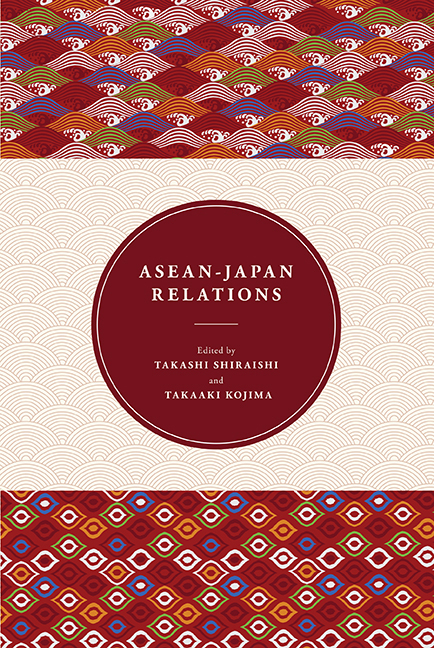Book contents
- Frontmatter
- Contents
- Preface
- About the Contributors
- 1 An Overview of Japan-ASEAN Relations
- 2 Japan's Relations with ASEAN
- 3 Approaches toward Regionalism: Japan, China and the Implications on ASEAN
- 4 The New Japan-ASEAN Partnership: Challenges in the Transformation of the Regional Context in East Asia
- 5 ASEAN-Japan Strategic Partnership and Regional Integration: Impacts and Implications
- 6 ASEAN-Japan Cooperation on Maritime Non-Traditional Security Issues: Toward a New Paradigm
- 7 Japan's Evolving Security Concerns in Maritime Southeast Asia: From Safety of Navigation to “Lake Beijing”
- 8 Evolution of Institutions and Policies for Economic Integration in East Asia: The Rise of China and Changes in the Regional Order
- 9 Managing Integration in East Asia: Behind Border Issues in Japan-ASEAN Trade Agreements
- 10 Regional Financial Cooperation in East Asia: Development and Challenges
- 11 Japanese Development Assistance to ASEAN Countries
- 12 Japanese Foreign Direct Investment in the ASEAN-4 Countries
- 13 Japan's Triple Tsunami
- 14 ASEAN-Japan Relations: A Singapore Perspective
Preface
Published online by Cambridge University Press: 21 October 2015
- Frontmatter
- Contents
- Preface
- About the Contributors
- 1 An Overview of Japan-ASEAN Relations
- 2 Japan's Relations with ASEAN
- 3 Approaches toward Regionalism: Japan, China and the Implications on ASEAN
- 4 The New Japan-ASEAN Partnership: Challenges in the Transformation of the Regional Context in East Asia
- 5 ASEAN-Japan Strategic Partnership and Regional Integration: Impacts and Implications
- 6 ASEAN-Japan Cooperation on Maritime Non-Traditional Security Issues: Toward a New Paradigm
- 7 Japan's Evolving Security Concerns in Maritime Southeast Asia: From Safety of Navigation to “Lake Beijing”
- 8 Evolution of Institutions and Policies for Economic Integration in East Asia: The Rise of China and Changes in the Regional Order
- 9 Managing Integration in East Asia: Behind Border Issues in Japan-ASEAN Trade Agreements
- 10 Regional Financial Cooperation in East Asia: Development and Challenges
- 11 Japanese Development Assistance to ASEAN Countries
- 12 Japanese Foreign Direct Investment in the ASEAN-4 Countries
- 13 Japan's Triple Tsunami
- 14 ASEAN-Japan Relations: A Singapore Perspective
Summary
In the autumn of 2011 I proposed a joint study on ASEAN-Japan relations to Ambassador K. Kesavapany, then director of the Institute of Southeast Asian Studies (ISEAS), and Professor Takashi Shiraishi, president of the Graduate Institute of Policy Studies (GRIPS). They gave their consent to my proposal. Ambassador Tan Chin Tiong, director of ISEAS, added his support to the project.
The objectives of the proposed joint study were to re-examine and critically analyze relations between ASEAN and Japan and to give future perspectives and directions. I was of the view that despite its importance, the ASEAN-Japan relationship had been undervalued and overlooked on both sides in recent years. In this respect, however, I am happy to observe that there has been a favorable change, especially since Shinzo Abe came back to power as prime minister of Japan in December 2012. He is focusing on ASEAN as one of the pillars in his foreign policy.
To implement the joint study, Professor Shiraishi and I tried to recruit competent contributors not only academics but also practioners from ASEAN and Japan to cover various fields such as foreign policy, security, business, development assistance, and fiscal cooperation and to shed light from different angles. We are grateful that Professor Tommy Koh, ambassador-at-large at Singapore's Ministry of Foreign Affairs, Professor Kishore Mahbubani, dean of the Lee Kuan Yew School of Public Policy, and Rodolfo Severino, former ASEAN secretary-general, accepted our request to contribute.
I acknowledge the support of the Japan Foundation, which provided the grant for the publication of this monograph. I would like to express my appreciation also to six generous donors to the project: Mitsubishi Corporation, Mitsui, Sumitomo Corporation, Itochu Corporation, Marubeni, and Sojitz Corporation.
I am indebted to Sunandini Arora Lal, Wee Wong, and Dr. Motoko Kawano of GRIPS for their painstaking efforts at editing this monograph.
Last but not least, I thank Professor Shiraishi, co-editor of this monograph. Without his distinguished expertise and extensive network, this publication would not have been possible.
- Type
- Chapter
- Information
- ASEAN-Japan Relations , pp. vii - viiiPublisher: ISEAS–Yusof Ishak InstitutePrint publication year: 2013

